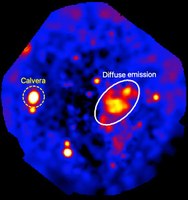CALVERA EXPLODED WHERE IT SHOULDN’T HAVE: A “RUNAWAY” PULSAR DEFIES THE RULES OF THE MILKY WAY
A stellar explosion, a pulsar, and a supernova remnant - that’s the story of Calvera. Positioned more than 6,500 light-years above the Galactic plane, this system is rewriting what we know about stellar evolution in our galaxy. The research originates from a team at the Italian National Institute for Astrophysics (INAF), in collaboration with the University of Palermo, and is detailed in a study published in Astronomy & Astrophysics.
Rome, 29 August 2025 - Researchers from the Italian National Institute for Astrophysics (INAF) and the University of Palermo have conducted a detailed study of a truly unique system: a pulsar and its associated supernova remnant located over 6,500 light-years above the Milky Way’s disk, an area previously considered nearly devoid of such objects. Based on new observations and analysis published in Astronomy & Astrophysics, this research challenges the notion that the Galaxy’s peripheral regions are energetically inactive, offering fresh insights into the origins and evolution of massive stars.
In a region where stellar density thins out, and the interstellar emptiness dominates, a rare supernova remnant with its runaway pulsar - named Calvera - is rewriting the rules of stellar life cycles. The pulsar’s name pays homage to the antagonist from the 1960 western film The Magnificent Seven, evoking its identity as a rebel on the fringes.
The story of Calvera’s supernova remnant begins in 2022, when LOFAR - a European network of radio telescopes designed for low-frequency sky surveys - detected an extended, nearly circular structure suggestive of a supernova remnant. Located at a galactic latitude of 37 degrees, far from the densest regions where such explosions typically occur, the remnant was found just arcminutes away from the well-known X-ray-emitting pulsar, Calvera. With a high proper motion measured at ~78 milliarcseconds per year, Calvera appears to be moving away from the explosion site, suggesting a physical link between the two: a massive star exploded millennia ago, leaving behind an expanding gas shell and a fleeing neutron star.
To reconstruct this cosmic story, the research team led by Emanuele Greco (INAF) analysed detailed X-ray data from ESA’s XMM-Newton satellite. Combined with the pulsar’s motion and multi-wavelength observations, the analysis estimates the remnant’s distance to be between 13,000 and 16,500 light-years and its age to be between 10,000 and 20,000 years - entirely consistent with the pulsar’s data, reinforcing their shared origin from the explosion.
“Massive stars - at least eight times the mass of the Sun - form almost exclusively in the galactic plane, where dense gas fosters star birth,” explains Greco. “Finding their remnants at such heights above the disk is exceedingly rare. Our study refined the distance, age, and even potential progenitor of the Calvera system with higher precision.”
Adding intrigue, the system resides in a notably different environment than the galactic plane. Despite expectations that high-energy gamma emissions require dense particle environments (primarily protons), the observed gamma-ray output originates in a remarkably diffuse region. This shows that even the Galaxy’s “outskirts” can host conditions capable of generating intense, high-energy emissions.
“Thanks to telescopes like XMM-Newton and Fermi/LAT, as well as ground-based facilities like the Telescopio Nazionale Galileo, we can examine supernova remnants and pulsars across the electromagnetic spectrum,” Greco continues. “We demonstrated that even sparse regions - if they contain local overdensities - may emit multi-million-degree plasma. These features reflect the progenitor’s evolutionary history.”
The study represents a collaboration between INAF facilities in Palermo and Milan, combining expertise in compact objects and diffuse supernova structures. Observations from the Telescopio Nazionale Galileo revealed ionised hydrogen filaments. At the same time, X-ray data revealed a spatially extended but compact structure with shockwave interactions, indicating that the area, although remote, can locally contain concentrations of matter, contrary to what is usually assumed for high galactic latitude regions.
The results - and the connection between the pulsar Calvera and its supernova remnant - show that massive stars can unexpectedly be found far from the Galactic plane. Some of these stars escape their birthplace and explode as supernovae in remote regions of the Galaxy, leaving behind an expanding cloud of gas and a compact object such as a neutron star.
“Calvera shows that even seemingly quiet and empty zones of our Galaxy can harbour extreme processes,” Greco concludes. “We’ve tightly constrained Calvera’s physical properties and confirmed that locally dense pockets, even far from the plane, can produce X- and gamma-ray emissions. The discovery encourages us to view the Milky Way’s periphery with fresh eyes.”
Related journal article: “Multi-wavelength study of the high Galactic latitude supernova remnant candidate G118.4+37.0 associated with the Calvera pulsar”, by Emanuele Greco et al. Forthcoming in: Astronomy & Astrophysics.
Multimedia:
Fig.1: X-ray image of the Calvera neutron star, marked by the yellow circle, and of the diffuse emission, identified by the white ellipse. The material responsible for the observed emission has a temperature between 1 and 10 million degrees Celsius. Credits: E. Greco/INAF.
Photo: Emanuele Greco, researcher at INAF in Palermo. Credits: INAF
Contacts:
INAF Press Office - Marco Galliani, +39 335 1778428, ufficiostampa@inaf.it - Eleonora Ferroni +39 3313144670 eleonora.ferroni@inaf.it






